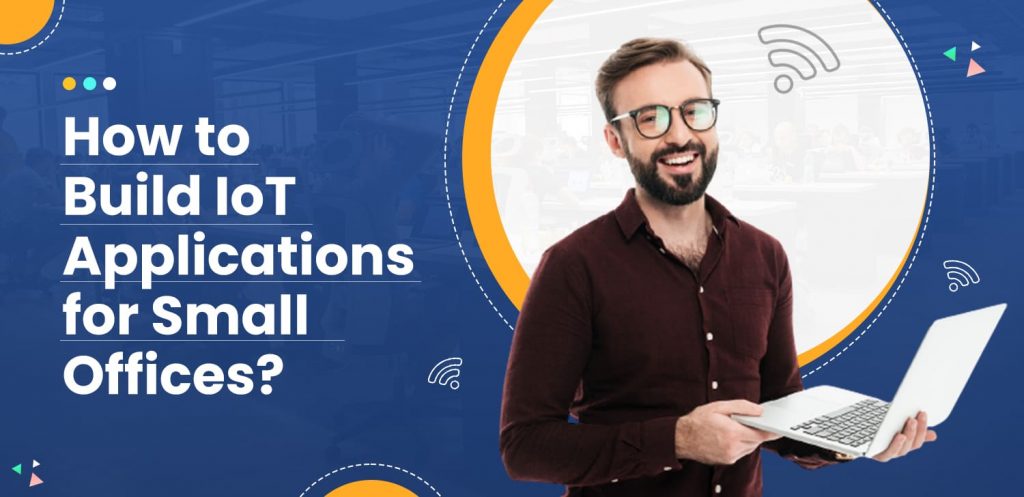
IoT is changing how we work and run businesses at a breakneck speed. In the last decade alone, IoT has made office spaces smarter and more efficient. Companies big and small are heavily investing in IoT to make their inner processes more streamlined and cut out any resource wastage.
According to Fortune Business Insights, the global IoT market was worth $250.72 billion in 2019 and is expected to reach $1.463.19 trillion by 2027. This massive adoption of IoT clearly shows a rapidly growing interest from companies and consumers. Big corporations such as Amazon and Walmart are already deep in their IoT adoption and use it for various purposes.
But IoT implementation and applications can also help small offices and businesses.
At its heart, IoT is about creating a transparent ecosystem of interconnected devices. With the help of proper IoT implementation and IoT app development, small offices can automate aspects of their business process, reinforce their data security measures, and elevate the productivity of their resources.
With the cost of high-end IoT sensors and wireless devices becoming more reasonable in recent years, it has become possible for smaller offices and businesses to implement IoT on their premises. And in today’s post, we will learn how you can develop an IoT application for your small office.
How can You Turn Your Small Office into a Smart Office?
IoT can help you make your office smarter. You can create a more efficient working environment by placing IoT sensors and wireless devices in optimal locations and coupling them with a well-designed software backend. Given below are the top six ways you can use to build a smarter office.
1. Intelligent HVAC and Lighting Systems
The biggest contributors to resource wastage in office spaces are globally managed HVAC and lighting systems. People often leave lights and air conditioners on when they leave a room. Some even leave their computers running by mistake when they leave. Furthermore, parts of an office space often eat more than the usual amount of energy due to a fault. All of this puts a tremendous financial burden on the office and is also very hazardous to the environment.
As a result, many small offices employ IoT to make their HVAC and lighting systems more efficient. Motion sensor lights can learn employee schedules and turn themselves on and off, thus replacing motion sensors. Multi-colored light bulbs can detect the amount of natural light coming into a room and change hues accordingly. These bulbs save energy and put less strain on the eyes of the occupants of the room.
For HVAC and lighting systems, IoT sensors and local submeters can help managers create localized criteria. For instance, if there are two departments in the office, one leaves around eight, and the other one leaves around six, then the IoT sensors will pick up on this trend and automatically manage energy flow based on room occupancy.
Read More: Explore the transformative impact of IoT-enabled smart lighting systems for smart cities, enhancing energy efficiency, reducing costs, and improving public safety.
2. Smart Locks
Smart locks make office spaces secure. These can be placed in critical locations where only certain authorized people are allowed to go, like server rooms. Or they can be placed in front gates and storage units.
Smart locks are IoT-based devices that work on digital keys that can’t get stolen or lost. Most offices use cards that have digital keys attached to them. Even if the card is lost, the person’s key is secure. IoT smart locks make it easier for managers to make new keys and revoke key access. Once the access has been revoked from the system, the person can’t get the locks to open. Lastly, smart locks also help managers record each employee’s comings and goings. Every time a key is accessed to open a door, an entry is made in the database. Using this data, managers can detect trends in the comings and goings of their employees. Also, it helps track entries to critical locations if something bad happens.
3. Heatmaps Using Connected Cameras and IoT Sensors
IoT helps managers with activity tracking in their offices. A system of connected cameras and IoT sensors combined with a well-designed IoT application creates heatmaps of different rooms in the office space. Managers can find out the occupancy of various rooms such as the breakroom, the conference rooms, the various hallways, etc. Using this data, managers can find out which room in the office sees the most traffic at a certain time. Furthermore, they can find out which rooms are overused or underused, and based on these deductions, they can provide more resources (more fans, air ducts, an extra coffee machine, etc.) or remove resources and use them someplace else.
4. Smart Office Equipment
IoT-enabled office devices like thermostats, printers, scanners, etc., are getting very popular. These devices can detect when they are running low on raw material, such as paper and ink for printers and coffee beans and milk for smart coffee machines. Then, these devices send notifications to the relevant employee to provide more resources.
They can also keep track of office inventory. If the office is running low on supplies like printer paper or coffee beans, they can send an alert, thus making sure that the office never runs out of stock.
Furthermore, these devices are capable of self-monitoring and have a fair amount of predictive capabilities if linked to a robust IoT application. Whenever these devices sense a potential breakdown, they issue a repair alert. The IT team can then send a person to look into the matter and fix these machines before the breakdown can happen.
5. Equipment Tracking with IoT Tagging
In small offices where the BYOD (bring your own device) policy is not followed, device tracking can be a hassle. The IT department is constantly keeping track of which assets were assigned to which employee. Without an automated tracking system, they must manually track company laptops, mobile devices, etc.
Small offices can place IoT tags on their devices to solve this problem.
Each device belongs to a particular family of devices, and within that family, it has a unique identity. When a device is assigned to an employee, that employee’s ID is written in front of the device ID. And once the device is returned, the employee ID is cleared from in front of the device, and it is made available to someone else. This way, the IT department doesn’t have to track office devices manually. Furthermore, if an employee needs a certain device urgently, they can very easily track it with the help of a shared IoT application.
Read More: Internet of Things: Reasons Why IoT can Revolutionize the Financial Sector?
6. Global Office Assistants
You can integrate a virtual assistant into your company network to make your office smarter, like Alexa and Siri. But while most AI assistants are for personal use, Alexa for Business is a shared, global virtual assistant that anyone in the office can access. From checking weather reports and scores for big games to finding meeting schedules, these assistants can bring your entire office in sync.
How to Build an IoT Application for Your Small Office?
Given above is a list of various operations you can do with the help of IoT. And now that you know what amazing possibilities await you let’s learn how you can develop an application for your small office and make it smarter and more efficient.
1. Define Your IoT Goals
We talked about many use cases IoT can have for an office space. And if you like all of them and want to bring them to your office, you can. But the smarter thing to do is take it one step at a time. Changing your office space inside out would disrupt your day-to-day business activities, causing you losses. So, to start, you need to define your IoT goals. Take a look at your office space and make a list of things that need to be streamlined. These are the pain points of your office that need to be addressed. For instance, if employees in your office come and go as they please and you want to fix this problem, or if you are constantly struggling with equipment maintenance and inventory management, you need to make fixing these issues your priority.
This list will depend on how you run your office space and whether you have the resources to fix those issues. It happens all too often that office managers have lofty goals but fall short because of reasons like budget constraints or sub-optimal employee training. So make sure you make achievable goals or break bigger goals into more achievable parts.
2. Conduct Market Research and Competitor Analysis
Once you have defined your IoT goals, you can start looking for ways to meet them. There are countless IoT solutions in the market that can help you transform your office space. But you need to choose a solution that fits your needs and budget. A good way to know what solutions you should bring is employee interviews and surveys. You can get your employees involved in the process and get their input on possible solutions. You can also look at other office spaces, like your competitors’, and how they implemented IoT to become smarter and more efficient. You don’t have to copy them exactly, but you can learn from what they got right and avoid their mistakes.
3. Make a Plan
Now that you have your research and goals, you can start planning your app. A detailed plan will require the involvement of an IoT expert. But you can start coming up with features that you need in your app, the platforms it will run on, etc. On top of that, you can decide on the budget for the app as well. While asking the board for a budget to implement IoT in your office space, you need to show them the value it will bring to your business. And for that, you need to justify this investment with facts and make the board understand the need for IoT implementation in your office space.
4. Hire an IoT Application Developer
Every IoT device needs a robust and secure software layer, like an application, to manage it. Without these devices, there is no way for the owners to interact with these devices or get real-time data. To complement state-of-the-art IoT sensors and wireless devices, you need a well-designed application with emerging tech such as AI and ML. From choosing the right IoT devices to building an application, you need an IoT expert who can guide you through the entire process.
And this is where IoT application development companies come in. While big companies such as Amazon have their in-house development teams, small offices can’t afford to maintain big teams like that. If you have a full-time development team, you need to pay their salaries and provide them with equipment and other resources, all of which add a financial burden to the office. So a better approach for small offices is to hire an IoT application development firm that can handle the development for them.
There are many talented IoT developers in the market who provide their services at reasonable rates. But you must find a developer who respects your vision and is willing to work with you. Most development firms charge on a per-hour basis and work on the agile development methodology where the client is at the center of the entire development process. They receive periodic updates about the state of the project, goals, milestones, etc., and are required to participate in the critical development meetings actively.
To find the perfect development partner, you can use platforms such as Clutch, where you will find genuine client reviews for development firms. Also, before hiring a enterprise software development company, make sure you look at their portfolio to see what type of projects they have worked on in the past.
5. Develop an IoT Application for your Small Office
Your IoT development company will help you create a detailed application plan. Their experience and expertise will allow them to fine-tune your application and give you crucial feedback. They will also suggest which devices to use and tell you all the possible avenues to help you achieve your IoT goals.
Based on your needs, you can get an offline IoT application that runs on the company’s network or work with a cloud IoT platform. Cloud IoT platforms, like Microsoft Azure or AWS IoT Greengrass, are highly customizable and can cater to your every need. Your IoT experts will guide you toward the right solution for your small office.
Your entire IoT implementation can take some time to be finished, depending on your needs. The more complex the implementation, the longer it will take to be done. The cost of development will also vary based on the project’s complexity. You should first ask your developers to create a Proof of Concept (POC) for their proposed implementation. If the POC gives the required results, you will know that their implementation works, and you can confidently move ahead.
Also Read: IoT Consulting Services: Everything You Need to Know
6. Test and Deploy the Application
A buggy IoT system can be disastrous for your office. Imagine lights and HVAC systems turning on and off out of their whimsy and smart equipment failing to act smart. That is why it is vital to test the entire IoT system before deploying.
Based on the implementation, the deployment can be on the local network or the cloud platform. After the deployment, you will have to teach your employees how to use the new systems for maximum efficiency.
7. Update and Maintain the Application Post-Launch
Once the base version of your IoT system is implemented, you need to work on patching the bugs. No matter how thorough the testing phase was, all IoT systems show bugs when they first start working in a real-world environment. Depending on the complexity of your implementation, the bugs can range from minor to system breaking, and you will need to fix them as soon as possible. Remember that a buggy system is as good as no system.
After the base version of your IoT implementation is stable, you can start working on adding more features and creating a better system based on the new data.
Conclusion
IoT application development can help small offices become more efficient and streamlined. It can reduce resource wastage and simplify their business processes. IoT creates an intelligent mesh of interconnected devices that can help you manage your small office efficiently.
If you want to implement IoT in your small office, then Matellio has years of experience creating robust IoT software solutions and architectures for companies of different sizes. Matellio’s IoT experts guide our clients through every step of their IoT implementation and provide consultation to improve the project. Our IoT developers work round the clock to ensure you get the solution you envisioned.
To learn more about our IoT development services, click here.






